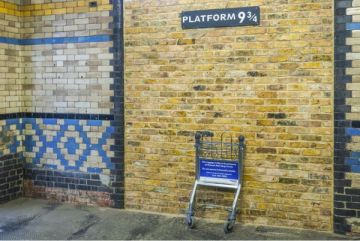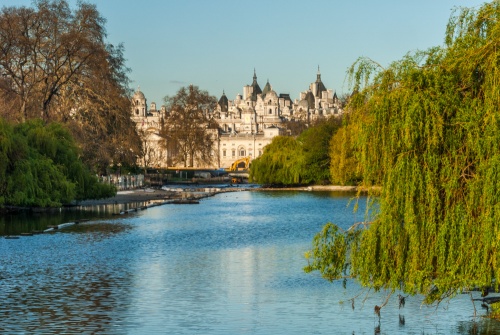
In 1530 Henry VIII seized lands belonging to his Chancellor, Cardinal Thomas Wolsey. Among Wolsey's estates was York Place, an opulent residence near the royal Palace of Westminster. Henry intended to make York Place, soon to be renamed Whitehall, his main London residence.
In 1532 Henry purchased an area of marsh bordering on Whitehall to the west, intending to create a deer park. The area was known as St James, after a 13th-century leper hospital on the site that was dedicated to that saint. On one side of the park he built a hunting lodge, which later grew to become St James Palace.
It was left to a later king, however, to drain the marsh and create the green space we now know as St James Park, the largest of the 8 royal parks in London.
When James I took the throne in 1603 following the death of Henry's daughter Elizabeth I, he ordered the marsh to be drained and landscaped to create a royal park. Not only was the new park a pleasant green space, but it housed a royal menagerie, with exotic birds, an elephant, crocodiles, even a camel.
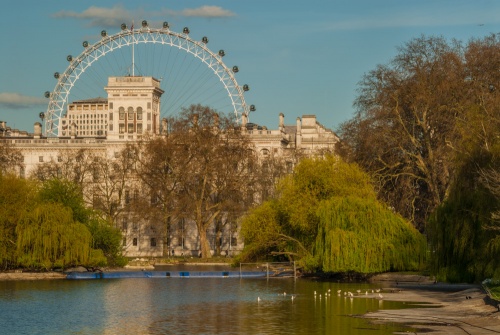
The park was developed further by James' grandson Charles II. When Charles was in exile during Oliver Cromwell's Commonwealth he was struck by the elegant formal gardens of the French royal palaces like Versailles. When he was returned to power he called upon French architects to lay out the park in a formal style, and introduced a long tree-lined canal as a central feature.
King Charles used the park to entertain guests, but he also opened it to the public. Access by the public made St James Park a popular meeting place for 'lecherous acts'. Perhaps the public was only following the king's lead, for Charles was known to bring his mistresses here, including his most famous mistress, Nell Gwynn.
Courting couples had to share space with livestock, for cattle were allowed to graze in the park during the 17th and 18th centuries. You could even buy fresh milk in the park.
Charles II frequently played 'pelle melle' in the park; a French game for which he acquired a taste while in exile. The name of the game was immortalised by the wide processional route on the north side of the park called The Mall.
Part of Charles II's canal was destroyed in the 18th century when Horse Guards Parade was built on the east side of the park. Horse Guards is still technically a part of the park, and is known as the site for the Trooping of the Colour ceremony.
In 1826 the Prince Regent (soon to become George IV) called upon the architect John Nash to remodel the park. Nash changed the design of the canal to create a gently curving lake (St James Park Lake), and the formal, straight avenues were replaced with winding paths. The rigid formality of Charles II's French-inspired design was softened to create a fore informal, romantic space. The park we see today is essentially as Nash designed it.
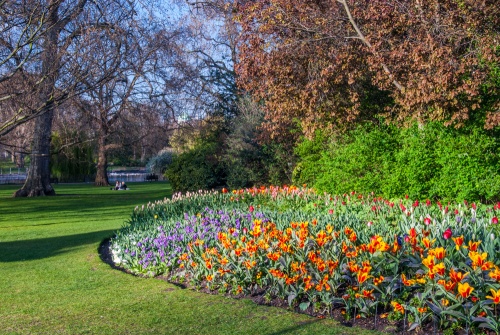
Within St James Park Lake are a pair of small islands, West Island and Duck Island. The latter is aptly named, for large numbers of waterfowl congregate around the lake, including mute swans. The island was built on the site of a duck decoy established as early as the Tudor period.
Here you can see large numbers of the park's resident colony of pelicans, descendants of birds given to Charles II by the Russian ambassador in 1664. The gift started a custom, and even today ambassadors to the UK frequently give the gift of a pelican to the park. From the waters of the lake rises a 20ft plume of water known as the Tiffany Fountain.
Crossing the lake is the Blue Bridge, which offers magnificent views west towards Buckingham Palace and east towards Whitehall and the London Eye. The first Blue Bridge was designed by John Nash. This was replaced in 1857 by an iron suspension bridge but this in turn was replaced by the present bridge in 1957.
The Diana Princess of Wales Memorial Walk passes through the park. Look for the raised, oval plaques that trace the route, linking major sites around the city that played a prominent part in the Princess's life.
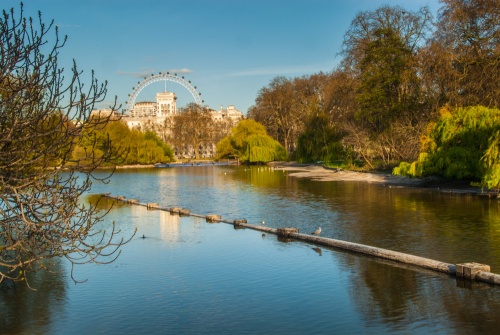
There are numerous statues and memorial surrounding the park, including memorials to George VI, Queen Elizabeth the Queen Mother, and Captain Cook.
To the north, The Mall was recreated as a wide processional avenue leading to Buckingham House, later renamed Buckingham Palace. The west end of the park terminates at the Victoria Memorial, erected in front of the Palace in 1924. The memorial acts to separate St James Park from another royal green space; Green Park.
Park Features
The Mall
The park is bordered on the north by The Mall, a wide processional route created in honour of Queen Victoria and linking Buckingham Palace to Trafalgar Square. The Mall is frequently used for royal processions during state occasions such as royal coronations, state visits and the state opening of Parliament. The Mall gets its name from Pelle Melle, a game similar to bowls, that was introduced into England by King Charles II. The game was traditionally played in St James Park.
Changing the Guard
The Mall also plays a central part in the popular Changing of the Guard ceremony and Trooping the Colour. The Changing the Guard ceremony (more properly called Guard Mounting) takes place daily at 11:00 in front of Buckingham Palace during the summer months, and on alternate days at other times.
In a ceremony taking about 30 minutes, the guards in front of the Palace are changed. When the monarch is in residence there are four Guards on duty and when the monarch is not in residence there are two Guards. A Guards band plays music ranging from military marches to modern pop songs while the Old Guards are changed for the New Guards.
Horse Guards Parade
Changing the Guards also takes place at Horse Guards Arch, off Horse Guards Parade at the eastern end of St James Park. Again, the ceremony takes place at 11:00 (10 am on Sunday mornings) and last 30 minutes. Horse Guards Parade is also the location for Trooping the Colour, held every year on the monarch's official birthday.
This military pageant is conducted by the Household Guards Division. The monarch personally inspects the Guards, then leads the troops along The Mall to Buckingham Palace. The ceremony is extremely popular and tickets to temporary grandstands lining Horse Guards Parade are allocated by a lottery. You can, however, also watch the ceremony and parade from the eastern edge of St James Park and from the park lining The Mall.
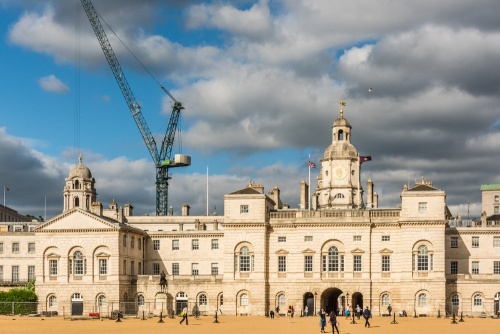
Duck Island and Swiss Cottage
This large manmade island is at the eastern end of the lake in St James Park. It acts as a nature reserve, hosting a large bird population. It was built in 1665, replacing a duck decoy. It acts as a breeding ground for some of the 17 different species of birds resident in the park, including mute swans and pelicans. The St James Park pelican colony began in 1664 as a gift to Charles II by the Russian ambassador. There are typically about 40 pelicans in the park, though they usually stick close to Duck Island.
On the eastern edge of the park is Duck Island Cottage, a Swiss-style chalet built in 1841 as a home for the park's official bird-keeper. The chalet also had a chamber reserved for the Ornithological Society of London, which once helped look after ducks and geese in the park. The design was intended to create a contrast with the grandiose government buildings that surround it.
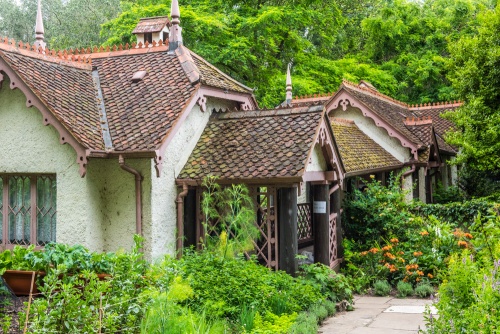
Tiffany Fountain
On the south side of Duck Island is the Tiffany Fountain, an eye-catching plume of water reaching 6m (about 20 feet) high. The fountain is sponsored by the famous Tiffany jewellery firm. It replaces an earlier fountain first installed in 1966 but later removed after it became too worn to function properly. The jet of water is aligned perfectly with the royal balcony at Buckingham Palace where the royal family appear during public events.
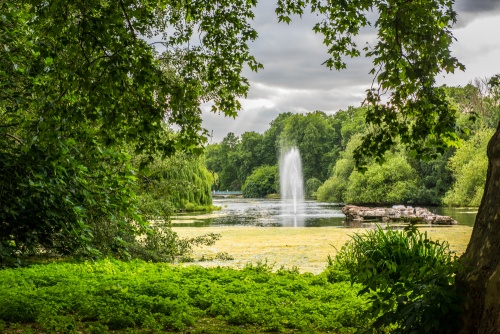
Monuments
Admiralty Arch
This grand processional arch spans the eastern end of The Mall and separates it from Trafalgar Square to the east. The arch was erected to commemorate Queen Victoria's death by her son and heir Edward VII. It was designed by architect Sir Aston Webb and erected in 1912. It takes its name from the adjoining Old Admiralty building. There are three central arches for vehicles and a pair of smaller flanking arches for pedestrians.
Inside the northernmost arch is a projection that looks like a human nose. It was said to commemorate the Duke of Wellington (known as Old Hooky for his prominent nose). Soldiers on horseback traditionally rub the nose for good luck as the ride under the arch.
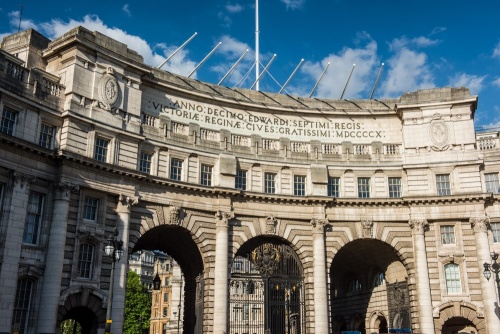
Graspan Royal Marines Memorial
On the northern side of Admiralty Arch is a memorial to Royal Marines who lost their lives in the Boxer Rebellion and the Boer War. The memorial consists of two bronze figures sculpted by Adrian Jones in 1903. The figures stand on a plinth of Portland stone, decorated by bronze plaques sculpted by Sir Thomas Graham Jackson. The plaques depict major battles of the two conflicts. It takes its name from the Battle of Graspan on 25 November 1899, part of the British relief of Kimberley. The memorial is a focal point for an annual Royal Marines parade.
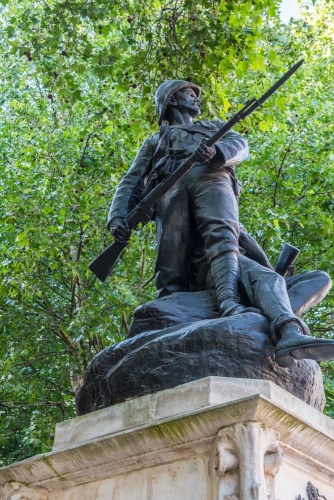
Captain Cook Statue
Near the south-western side of Admiralty Arch is a bronze statue to explorer Captain James Cook. It was sculpted by Sir Thomas Brock, who also designed the Queen Victoria Memorial outside Buckingham Palace. Apparently, Brock made a serious mistake in his sculpture; he shows Cook standing on a coil of rope, something that would be considered a seriously bad idea on board a ship.
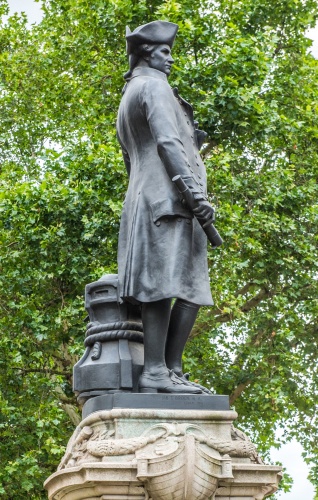
National Police Memorial
A few steps from the Captain Cook statue is the National Police Memorial, located at the junction of Horse Guards Road and The Mall. This modern memorial remembers police officers who died in the line of duty. It was unveiled in 2005 and takes the form of a black granite block (now largely covered in ivy). Set into the memorial wall is a glass chamber where you can see a book listing the names of dead police officers. The book's pages are turned every two weeks.
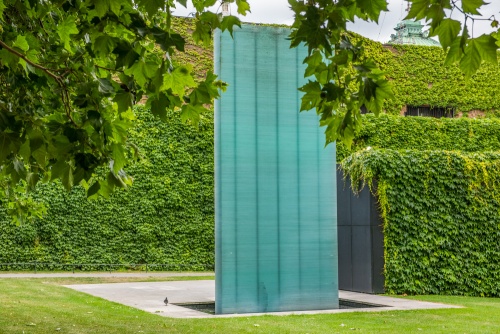
South African Royal Artillery Memorial
Opposite the Police Memorial, in the north-eastern corner of the park, is this memorial to members of the Royal Artillery killed in action during the Boer War (1899-1902). The memorial features a winged figure of Peace quieting a horse, representing War. The bronze sculpture stands on a plinth of Portland stone.
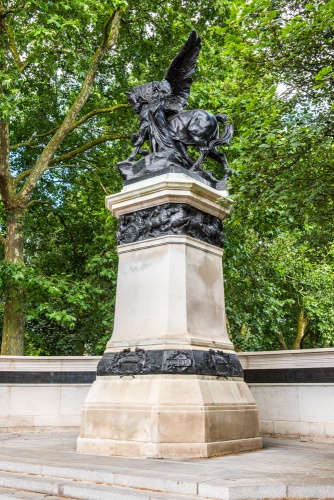
Guards Memorial
Directly opposite Horse Guards Parade and the Wellington Barracks is a memorial to the five Foot Guards Regiments - Scots, Welsh, Irish, Coldstream and Grenadiers - who lost their lives in World War One. The memorial takes the form of a cenotaph and was created by H. Chalton Bradshaw. An inscription was later added in memory of those killed during World War Two.
The sculptures were made from guns captured during the war. The Guards figures were modelled on real Guardsmen. Apparently, the Irish guardsman got tired of posing for the sculptor and left early. As a result, his legs are modelled after another guardsman.
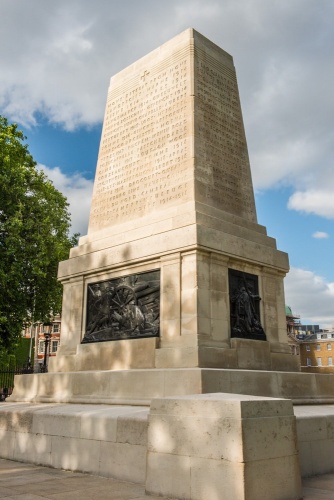
Royal Naval Division Memorial
Opposite the Guards Memorial and tucked away next to the Old Admiralty Buildings is this relatively subdued memorial to members of the Royal Naval Division who died in WWI. The Division was formed by Winston Churchill at the outbreak of the war and served at Gallipoli before it was disbanded following the war.
The memorial is composed of a fountain topped by an obelisk. It is inscribed with a verse by poet Rupert Brooke, who died while serving with the Division in 1915. The memorial was designed by Sir Edwyn Lutyens and unveiled by Churchill himself in 1925.
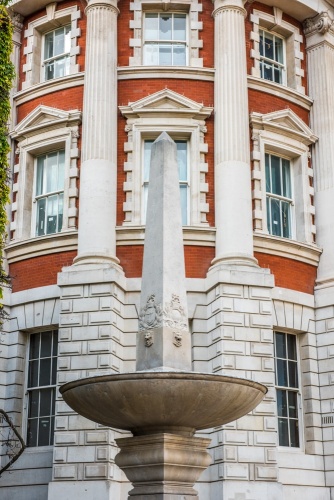
Bali Memorial
This poignant memorial stands beside the Clive Steps on the far side of Horse Guards Road. It commemorates the 202 people who lost their lives in the Bali bombings in 2002. The memorial takes the form of a large globe made of marble, set beside a curbing stone wall where the names of all the victims are inscribed.
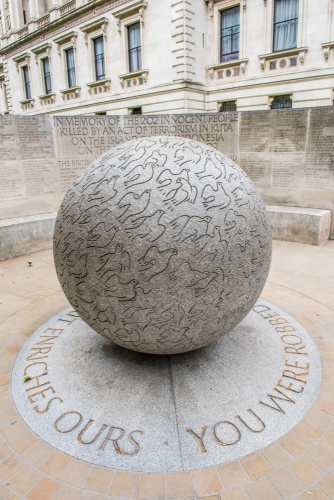
Blue Bridge
This low, three-arched pedestrian bridge spans the lake in the centre of the park. From the centre of the bridge there are excellent views east to Whitehall and west to Buckingham Palace. This is the third bridge in this spot. The first was designed by John Nash, the popular Regency architect responsible for the Palace. Nash's bridge was replaced in 1857 by an iron suspension bridge. Exactly one hundred years later in 1957, the iron bridge was replaced by the present concrete one. It gets its name from the colour of its railings.
Boy Statue
This is one of the easiest monuments in the park to overlook. It stands opposite Queen Anne's Gate on Birdcage Walk, on the southern edge of the park. It shows the marble figure of a boy sitting on a plinth. Set onto the plinth are for shell-shaped basins that were originally used as drinking fountains. The statue was designed by Robert Jackson in 1863.
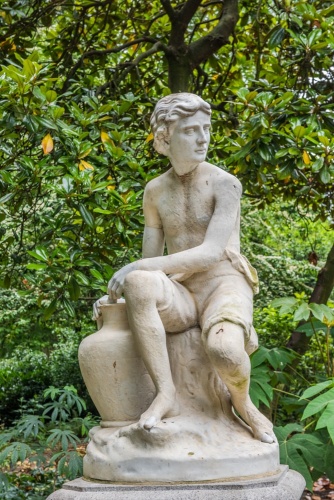
Queen Mother Memorial
Two linked memorials stand on the northern side of The Mall. Closest to the road is a figure of Queen Elizabeth, the Queen Mother, who died in 2002 at the age of 101. The statue was unveiled by HRH Queen Elizabeth II in 2009. It depicts the Queen Mother at the age of 51, when she was widowed. The bronze figure was funded by issuing a special 5-pound gold coin to commemorate the Queen Mum's 80th birthday.
George VI Memorial
A few steps high than the Queen Mother's statue is a memorial to her husband, King George VI. Designed by William McMillan, the statue shows the king in a naval uniform. It too was unveiled by HRH Queen Elizabeth, in 1955.
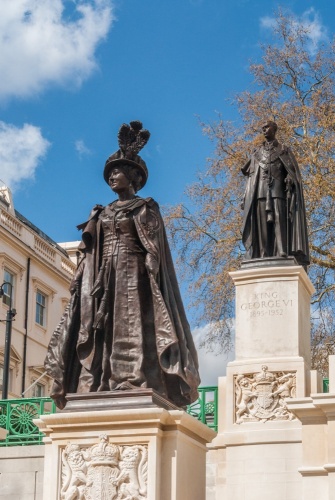
Duke of York Column
Also on the north side of The Mall is a huge column topped by a bronze statue of Frederick William (1763-1827), second son of King George III. The Duke served as Commander in Chief of the British Army and is thought to be the figure lampooned in the nursery rhyme 'The Grand Old Duke of York'. The neo-classical column was designed in 1824 by Sir Benjamin West and the statue by Sir Richard Westmacott. The duke was so heavily in debt at the time of his death that some wags suggested he stood on the high column to avoid his creditors.
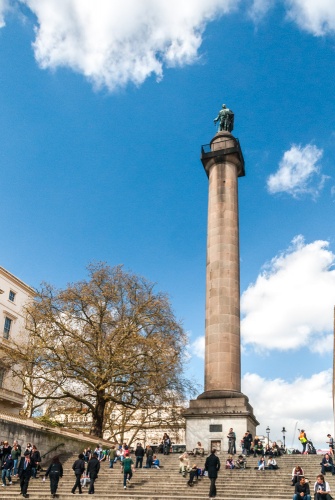
Queen Victoria Memorial
On a large traffic island in front of Buckingham Palace stands a memorial to Queen Victoria sculpted from Carrara marble. The memorial is reached by four ornamental sets of gates known as the Dominion Gates - one set each for South Africa, West Africa, Canada, Australia.
The huge central monument shows Victoria seated on a throne, surrounded by figures representing Truth, Courage, Charity, Victory, Constancy, and Motherhood. The memorial was created by Sir Thomas Brock but it forms part of the overall scheme, including the surrounding flower beds, by Sir Aston Webb.
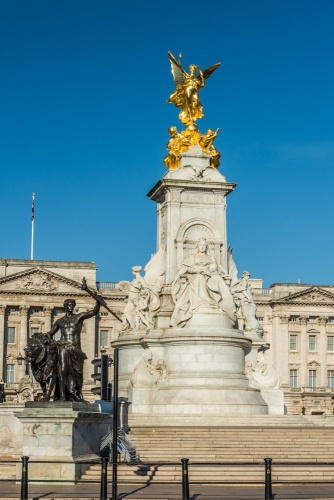
Buckingham Palace Flower Garden
The western end of St James Park terminates in the famous flower beds in front of Buckingham Palace. The garden beds were laid out by Sir Aston Webb in 1901 to commemorate Quen Victoria's death in that year. The garden beds are laid out as a semi-circle arranged around a central memorial. The beds are replanted each summer with over 22,500 plants including geraniums in a shade of scarlet to match the uniforms of the Queen's Guard. During the winter the beds are planted with 50,000 yellow wallflowers and red tulips to add colour.
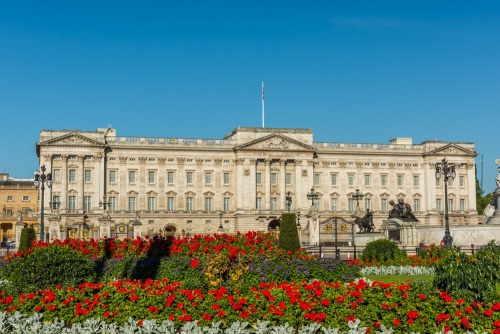
Visiting
The park is officially open from 5am until midnight. There are no car parks for vehicular access, and the closest tube stations are St James's Park, Green Park, Victoria, and Westminster.
About St James Park
Address: Birdcage Walk,
London,
Greater London,
England, SW1A 2BJ
Attraction Type: Countryside - Royal Park
Location: Between Buckingham Palace and Whitehall. Easy access off Birdcage Walk or The Mall.
Website: St James Park
Email: stjames@royalparks.gsi.gov.uk
Location
map
OS: TQ298798
Photo Credit: David Ross and Britain Express
Nearest station: ![]() Westminster - 0.2 miles (straight line) - Zone: 1
Westminster - 0.2 miles (straight line) - Zone: 1
HERITAGE
 We've 'tagged' this attraction information to help you find related historic attractions and learn more about major time periods mentioned.
We've 'tagged' this attraction information to help you find related historic attractions and learn more about major time periods mentioned.
Find other attractions tagged with:
NEARBY HISTORIC ATTRACTIONS
Heritage Rated from 1- 5 (low to exceptional) on historic interest
Churchill War Rooms - 0.1 miles (Museum) ![]()
Household Cavalry Museum - 0.2 miles (Museum) ![]()
Banqueting House - 0.2 miles (Historic Building) ![]()
Duke of York Column - 0.2 miles (Landmark) ![]()
Admiralty Arch - 0.3 miles (Historic Building) ![]()
Battle of Britain Monument - 0.3 miles (Landmark) ![]()
Boadicea and Her Daughters Statue - 0.3 miles (Landmark) ![]()
Westminster Abbey - 0.3 miles (Cathedral) ![]()
Nearest Holiday Cottages to St James Park:
Leaves Green, Greater London
Sleeps: 6
Stay from: £871 - 3614
More self catering near St James Park



